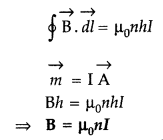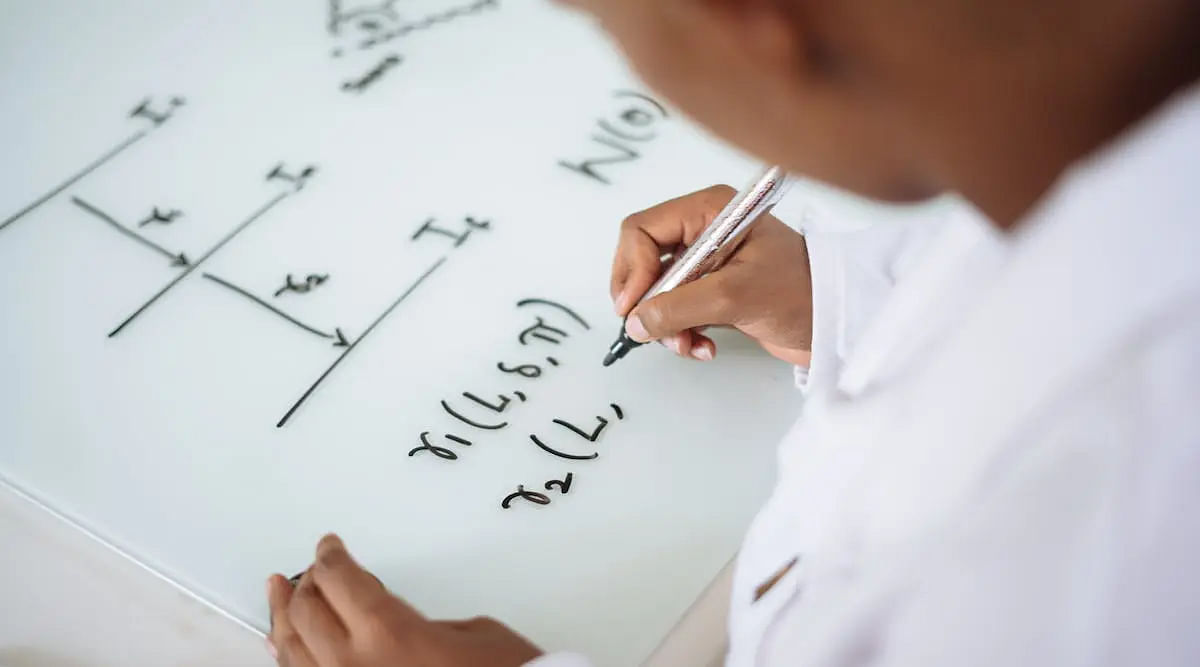CBSE 12th Exams Commence Soon: Check CBSE 12th Physics Chapter 4 Important Questions
Students can refer to the CBSE 12th Physics Chapter 4 Important Questions and solutions here to prepare for their upcoming CBSE Board Exam 2023.
CBSE 12th Physics Chapter 4 Important Questions: The Central Board of Secondary Education (CBSE), India, will conduct the class 12 Board exams between Feb 15 to Apr 5, 2023.
The Physics exam is scheduled for Mar 6. Students completing their CBSE 12th Physics revision must thoroughly study the fourth chapter, i.e., CBSE 12th Physics Moving Charges and Magnetism.
Continue reading further to check the CBSE 12th Physics Chapter 4 Important Questions and their solutions.
Also Read: Check CBSE 12th Physics Chapter 3 Important Questions
CBSE 12th Physics Chapter 4 Important Questions & Solutions
Find the CBSE 12th Physics Chapter 4 Important Questions and solutions for the fourth Chapter (Moving Charges and Magnetism) below.
- Question 1: Why should the spring/suspension wire in a moving coil galvanometer have a low torsional constant?
Answer: Low torsional constant is basically required to increase the current/charge sensitivity in a moving coil ballistic galvanometer. - Question 2: Magnetic field lines can be entirely confined within the core of a toroid, but not within a straight solenoid. Why?
Answer: At the edges of the solenoid, the field lines get diverged due to other fields and/or the non-availability of dipole loops, while in toroids the dipoles (in loops) orient continuously. - Question 3: Why do the electrostatic field lines not form closed loops?
Answer: Electric field lines do not form closed loops because the direction of an electric field is from positive to negative charge. So one can regard a line of force starting from a positive charge and ending on a negative charge. This indicates that electric field lines do not form closed loops. - Question 4: (a) In what respect is a toroid different from a solenoid? Draw and compare the pattern of the magnetic field lines in the two cases.
(b) How is the magnetic field inside a given’ solenoid made strong?
Answer: (a) Solenoid consists of a long wire wound in the form of a helix where the neighbouring turns are closely spaced, whereas, the toroid is a hollow circular ring on which a large number of turns of a wire is closely wound.
(b) Magnetic field inside a given solenoid is made strong by putting a soft iron core inside it. It is strengthened by increasing the amount of current through it. - Question 5: A circular coil of closely wound N turns and radius r carries a current I. Write the expressions for the following :
(i) the magnetic field at its centre
(ii) the magnetic moment of this coil
Answer:
(i) The magnetic field at the centre of a circular coil of N turns and radius r carrying a current, I is
(iii) Magnetic moment, M = NIA = NIπr2 - Question 6: State the underlying principle of working of a moving coil galvanometer. Write two reasons why a galvanometer can not be used as such to measure current in a given circuit. Name any two factors on which the current sensitivity of a galvanometer depends. (Delhi 2010)
Answer: (i) Moving coil galvanometer works on the principle of a torque experienced by a current-carrying coil placed in a magnetic field, whose magnitude is a function of current passing through the coil.
(ii) The galvanometer cannot be used to measure the value of the current in a given circuit due to the following two reasons:
(a) Galvanometer is a very sensitive device. It gives a full-scale deflection for a small value of current.
(b) The galvanometer has to be connected in series for measuring currents and as it has a large resistance, this will change the value of the current in the circuit.
(iii)
It depends on the number of turns N of the coil, the torsion constant and the area A of the coil. - Question 7: A beam of particle projected along the +x-axis, experiences a force due to a magnetic field along the +y-axis. What is the direction of the magnetic field?
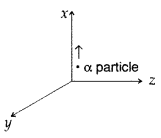
Answer: The direction of the magnetic field is towards the negative direction of the z-axis.
The direction of the magnetic field is towards the negative direction of the z-axis. - Question 8: A beam of electrons projected along the +x-axis, experiences a force due to a magnetic field along the +y/-axis. What is the direction of the magnetic field?
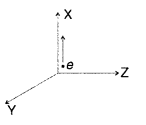
Answer: The direction of the magnetic field is F = q (v × B) towards the positive direction of the z-axis. - Question 9: Depict the trajectory of a charged particle moving with velocity v as it enters a uniform magnetic field perpendicular to the direction of its motion.
Answer: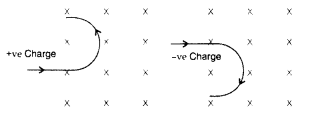
The force acting on the charged particle will be perpendicular to both v and S and therefore will describe a circular path. - Question 10: Write the expression in vector form, for the magnetic force F→ acting on a charged particle moving with velocity V→ in the presence of a magnetic field B.
Answer:
- Question 11: A charge ‘q’ moving B along the X-axis with a velocity v is subjected to a uniform magnetic field B acting along the Z-axis as it crosses the origin O. (Delhi 2009)
(i) Trace its trajectory.
(ii) Does the charge gain kinetic energy as it enters the magnetic field? Justify your answer.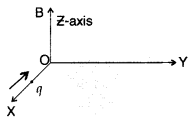
Answer: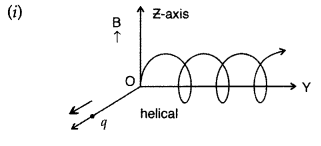
(ii) K.E does not change irrespective of the direction of the charge as
- Question 12: A proton and a deuteron, each moving with velocity enter simultaneously in the region of magnetic field B acting normally in the direction of velocity. Trace their trajectories establishing the relationship between the two.
Answer: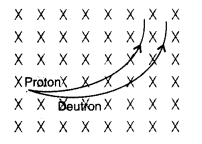
- Question 13: Define the term magnetic moment of a current loop. Derive an expression for the magnetic field at any point along the axis of a solenoid of length 21, and radius «, and the number of terms per unit length n.
Answer: (i) Definition of the magnetic moment: Magnetic moment of a current loop is equal to the product of the current flowing in the loop and its area, and its direction is along the area vector as per the right-handed screw rule.
(ii) Magnetic field for solenoid :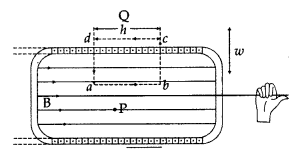
Using Ampere’s circuital law